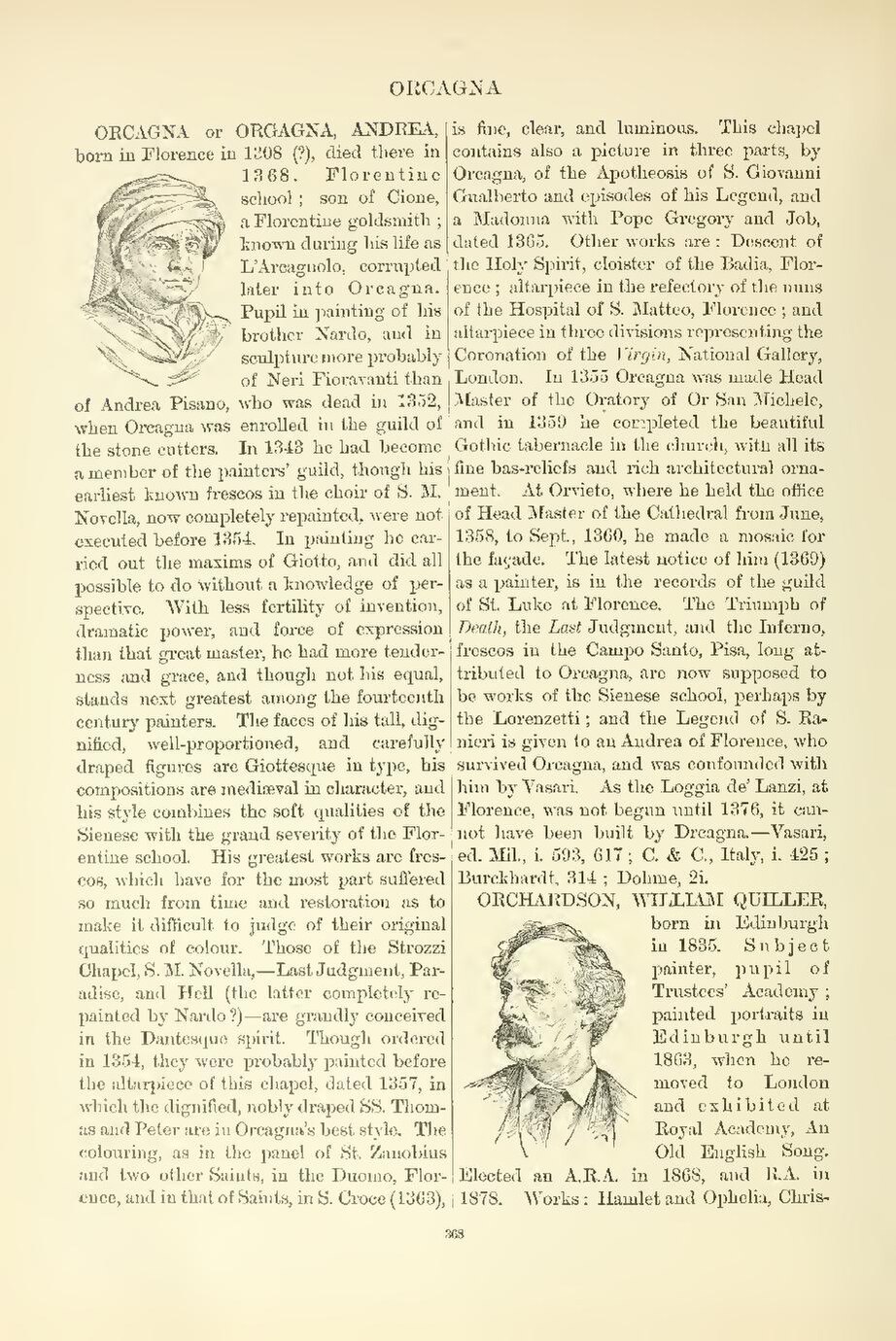An image should appear at this position in the text. To use the entire page scan as a placeholder, edit this page and replace "{{missing image}}" with "{{raw image|Cyclopedia of painters and paintings (IA cyclopediaofpain03cham).pdf/390}}". Otherwise, if you are able to provide the image then please do so. For guidance, see Wikisource:Image guidelines and Help:Adding images. |
ORCAGNA or ORGAGNA, ANDREA,
born in Florence in 1308 (?), died there in
1368. Florentine
school; son of Cione,
a Florentine goldsmith;
known during his life as
L'Arcagnolo, corrupted
later into Orcagna.
Pupil in painting of his
brother Nardo, and in
sculpture more probably
of Neri Fioravanti than
of Andrea Pisano, who was dead in 1352,
when Orcagna was enrolled in the guild of
the stone cutters. In 1343 he had become
a member of the painters' guild, though his
earliest known frescos in the choir of S. M.
Novella, now completely repainted, were not
executed before 1354. In painting he carried
out the maxims of Giotto, and did all
possible to do without a knowledge of perspective.
With less fertility of invention,
dramatic power, and force of expression
than that great master, he had more tenderness
and grace, and though not his equal,
stands next greatest among the fourteenth
century painters. The faces of his tall, dignified,
well-proportioned, and carefully
draped figures are Giottesque in type, his
compositions are mediæval in character, and
his style combines the soft qualities of the
Sienese with the grand severity of the Florentine
school. His greatest works are frescos,
which have for the most part suffered
so much from time and restoration as to
make it difficult to judge of their original
qualities of colour. Those of the Strozzi
Chapel, S. M. Novella,—Last Judgment, Paradise,
and Hell (the latter completely repainted
by Nardo?)—are grandly conceived
in the Dantesque spirit. Though ordered
in 1354, they were probably painted before
the altarpiece of this chapel, dated 1357, in
which the dignified, nobly draped SS. Thomas
and Peter are in Orcagna's best style. The
colouring, as in the panel of St. Zanobius
and two other Saints, in the Duomo, Florence,
and in that of Saints, in S. Croce (1363),
is fine, clear, and luminous. This chapel
contains also a picture in three parts, by
Orcagna, of the Apotheosis of S. Giovanni
Gualberto and episodes of his Legend, and
a Madonna with Pope Gregory and Job,
dated 1365. Other works are: Descent of
the Holy Spirit, cloister of the Badia, Florence;
altarpiece in the refectory of the nuns
of the Hospital of S. Matteo, Florence; and
altarpiece in three divisions representing the
Coronation of the Virgin, National Gallery,
London. In 1355 Orcagna was made Head
Master of the Oratory of Or San Michele,
and in 1359 he completed the beautiful
Gothic tabernacle in the church, with all its
fine bas-reliefs and rich architectural ornament.
At Orvieto, where he held the office
of Head Master of the Cathedral from June,
1358, to Sept., 1360, he made a mosaic for
the façade. The latest notice of him (1369)
as a painter, is in the records of the guild
of St. Luke at Florence. The Triumph of
Death, the Last Judgment, and the Inferno,
frescos in the Campo Santo, Pisa, long attributed
to Orcagna, are now supposed to
be works of the Sienese school, perhaps by
the Lorenzetti; and the Legend of S. Ranieri
is given to an Andrea of Florence, who
survived Orcagna, and was confounded with
him by Vasari. As the Loggia de' Lanzi, at
Florence, was not begun until 1376, it cannot
have been built by Drcagna.—Vasari,
ed. Mil., i. 593, 617; C. & C., Italy, i. 425;
Burckhardt, 314; Dohme, 2i.
An image should appear at this position in the text. To use the entire page scan as a placeholder, edit this page and replace "{{missing image}}" with "{{raw image|Cyclopedia of painters and paintings (IA cyclopediaofpain03cham).pdf/390}}". Otherwise, if you are able to provide the image then please do so. For guidance, see Wikisource:Image guidelines and Help:Adding images. |
ORCHARDSON, WILLIAM QUILLER,
born in Edinburgh
in 1835. Subject
painter, pupil of
Trustees' Academy;
painted portraits in
Edinburgh until
1863, when he removed
to London
and exhibited at
Royal Academy, An
Old English Song.
Elected an A.R.A. in 1868, and R.A. in
1878. Works: Hamlet and Ophelia, Chris-
